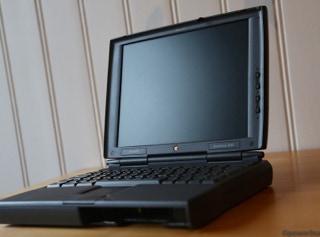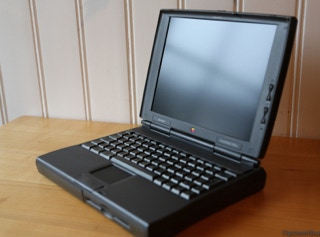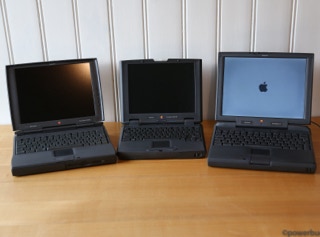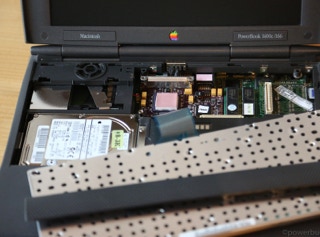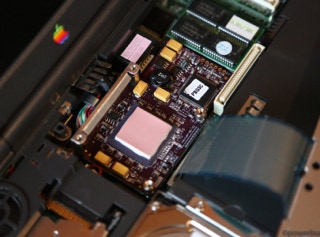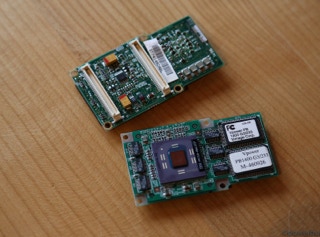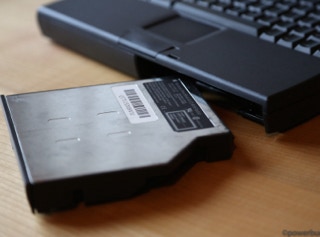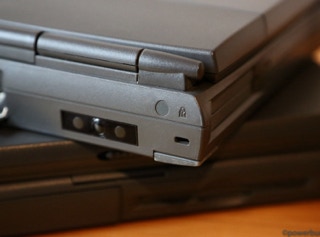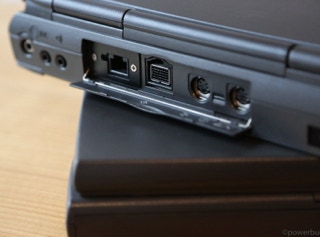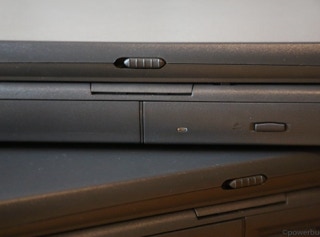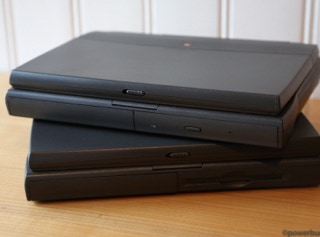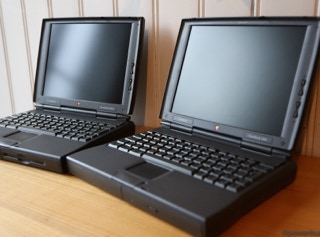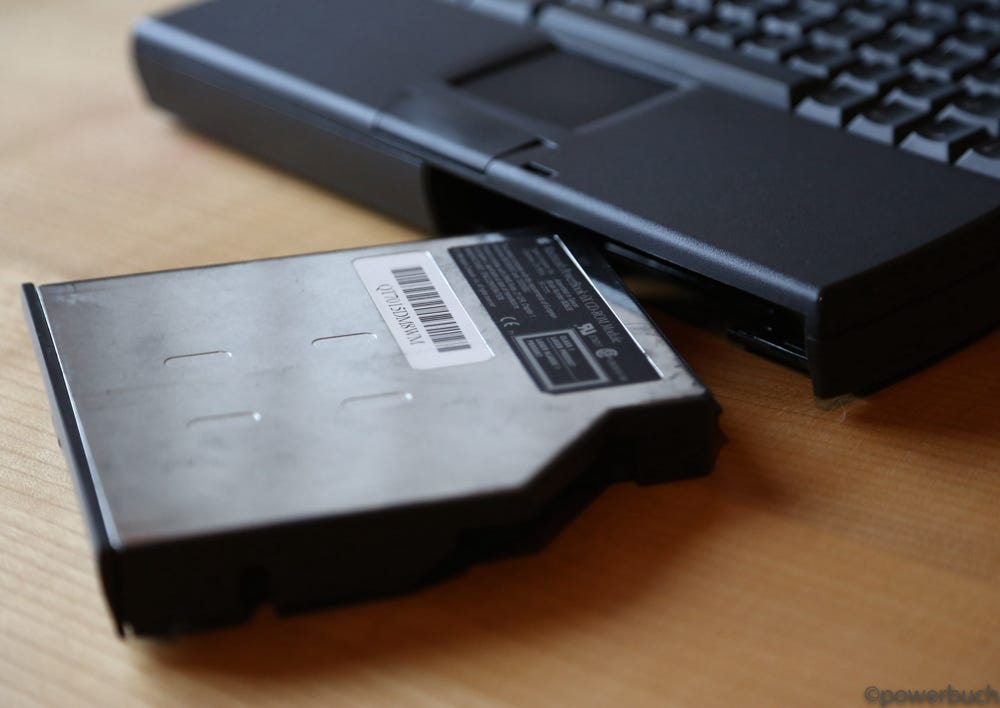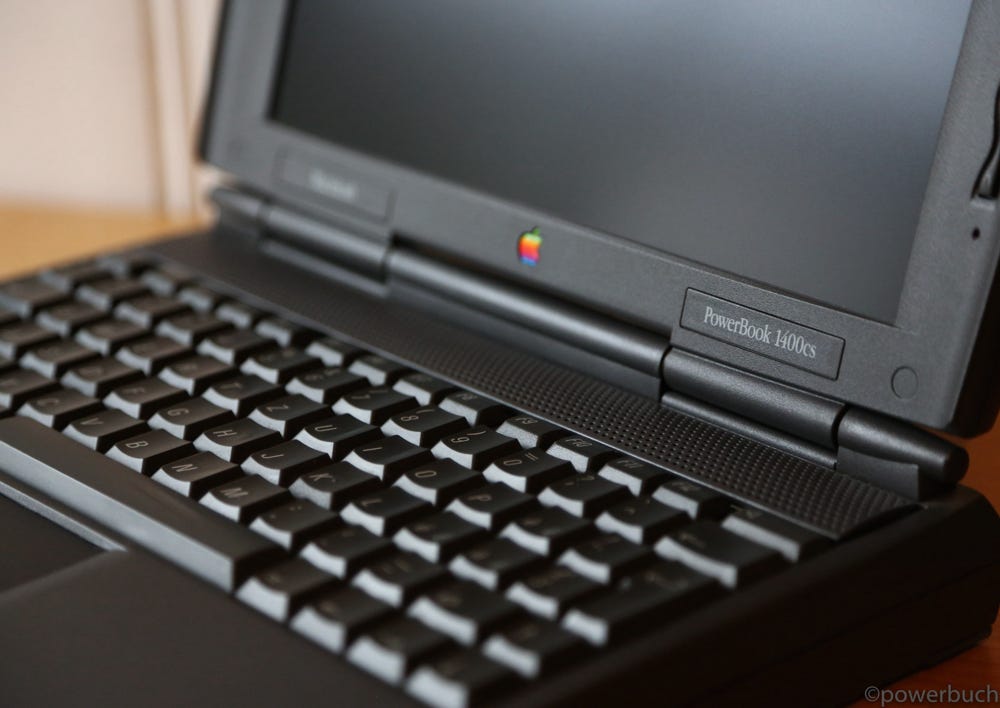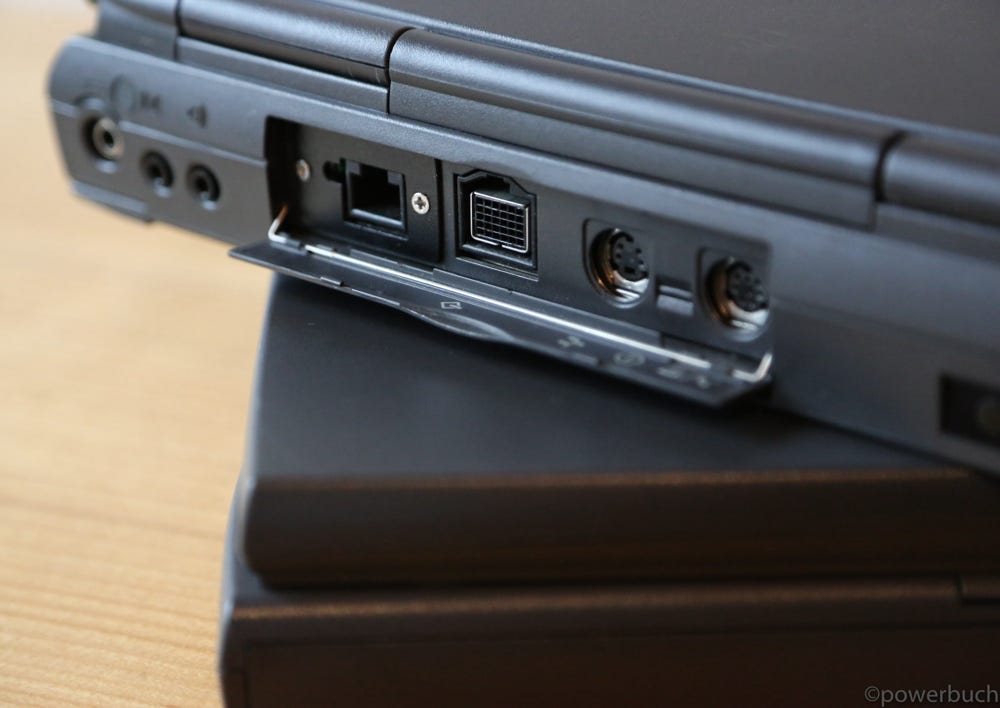powerbook 1400cs and 1400c
The powerbook 1400 was available in a number of different configurations and came with a 6x cd-rom modul. It was originally released with a 117 mhz powerpc 603e processor; later with a 133 mhz and the top line with a 166 mhz processor.
The 1400 was easily upgradeable. The cpu was located on a removable daughter card, which could be replaced with one containing a faster processor, including a number of commercially available cards with powerpc G3 processors from vendors such as sonnet technologies, newertech, and vimage. 64 MB of memory was twice as much as the previous model the powerbook 5300.
The powerbook 1400 had a higher screen resolution then the previous models mainly from 640x480 to 800x600 pixels (except the 5300ce) and came with an active matrix display (1400c) and a less expensive passive matrix, dual-scan display (1400cs). The book included also a separated graphic chip with 1 mb of dedicated memory. Originally the powerbook 1400 was shipped with system 7.5.2, the last still supported system was mac os 9.1.
after the disaster that was the 5300
Gil Amelio had to clean up the 5300 mess soon after he became ceo so it was important to right all of its wrongs with its successor. After the disaster that was the 5300 apple decided to go back to the drawing board for its next powerbook.
Soon after his arrival a plan was put in place to develop two new laptops to replace the 5300 – a lower-priced consumer model that would address quality and build issues and a high-end performance model that would finally give the powerbook the speed it needed to compete. Both were planned for a fall release but the performance model fell behind schedule leaving the powerbook 1400 series to replace the 5300 entirely in october 1996.
The 1400 has a flatter, boxier case than its predecessor, which makes it slightly thinner but half a pound heavier. While the 5300 is much more rectangular than the 500 series before it there are still portions of it that seem lumpy. The 1400 has a few nips and tucks that make it look more attractive while still retaining some curvature around the edges of the screen and flares on the sides of the palm rests. The screen hinges are significantly smaller, taking up less height and protruding less into the keyboard area. The 1400′s case is half an inch deeper than its predecessor which finally allowed apple to squeeze in a cd-rom drive into its expansion bay. To do this, the bay has been moved from the side of the case to the front which makes access a bit of an issue in cramped places such as an airplane. The bay takes either a 5.25″ drive such as a cd-rom drive or a 3.5″ drive such as a floppy or zip drive, however it does not accept drives from the 5300 as it uses a different design. The drive eject button is still located on the bottom of the machine but the button protrudes more and is easier to slide. The bay can also hold an extra battery but serves strictly as storage as there are no connections inside from which to draw power.
Other changes from the 5300 include larger 11.3″ color screens across the line that display 800 x 600 pixel resolution (grayscale is no longer available), the return of tap-and-drag to the trackpad, an upgradable cpu, and a firm and responsive keyboard that is one of the best in powerbook history. The case more rigid than the 5300 and the hardware doesn’t suffer from the rash of issues of its predecessor. The 1400 series also includes a unique feature called “book covers” where a panel on the top of the case can be replaced with an insertable picture, design, or accessory. A popular accessory at the time was a solar panel that could charge the battery while the laptop was asleep.
After adding a cd-rom and improving the build quality apple almost had everything right, but carry-overs from the 5300 prevented a perfect powerbook. The biggest carryover is the poor-performing cacheless 117 mhz 603e cpu. Performance of the base model 1400 is nearly the same as the performance of the high end 5300ce. Customers had to wait three months (january 1997) to buy the 133 mhz model which included a small but useful 128k l2 cache that increased performance by about 30%. Luckily apple put the cpu on a daughter card (similar to the powerbook 500 series) which allowed third parties to sell upgraded 603e cpus to boost performance. In addition to using the same cpus, the 1400 also uses the same aging nimh battery technology as the 5300. Apple didn’t want a repeat of the liion issues it had prior and continued to include the nimh batteries rated for 2-4 hours of run time. Ports are also mostly the same, including the non-pc compatible infrared port. Like the 5300, networking and modem capabilities are only available via a third party pc card.
The grayscale screen option from the 5300 was dropped, as was the high-end ce model, leaving only the 1400cs and 1400c. The major difference between the two is the screen – the 1400cs has a passive matrix screen and the 1400c has an active matrix screen. Both sport 800 x 600 pixel resolution at thousands of colors. The passive matrix screen, while lower quality than the active matrix screen, is better than the 5300′s even though it uses the same technology. The 1400 is also one of the few powerbooks of the time that does not include any sort of feet that can be used to angle the machine for more comfortable typing. It is also one of the few macs that can’t boot from a cd by holding the c key at startup.
Overall macworld was ambivalent about the 1400 stating that it has a “completely new design that presses neither technology limits and performance boundaries nor pocketbooks” and describing it as a “well-designed notebook [that] lacks true innovation”. Overall the magazine liked the addition of the cd-rom drive, larger screen, additional (though somewhat complicated) expandability, solid design, new keyboard, and lack of software bugs that plagued the 5300. The case design received high marks as well “lacking both the bulbous look of the 5300 and 190 and the boring boxiness of other laptops.” It lost points for the components that it didn’t improve from its predecessor, namely its poorly performing cpu, incompatible infrared port, and lack of geoport serial ports. Macworld rated the 117 mhz 1400c and cs a 6.4 out of 10.
The 1400 suffered from bad timing. It was intended to be apple’s lower-end notebook so pushing the performance and technology envelope was not its goal. Had apple’s high-end notebook (the 3400c) been ready and released at the same time as originally planned, the 1400 may have fared better in reviews. Without a high-end cousin the 1400 was left to satisfy needs for which it was not designed.
Eight months later, in july 1997, the 1400 line was refreshed with a 133 mhz cpu option, hard drive bump, and standard 8x cd-rom module for the 1400cs. A 166 mhz cpu, hard drive bump, and 12x cd-rom drive were offered for the 1400c. Pricing was set at $2,500 and $3,500, respectively. The 180 mhz powerbook 3400c had been on the market for five months by this time and the 1400 was finally serving the purpose it was designed for as apple’s least expensive laptop. A final update was made five months after that by making the 166 mhz cpu available on the 1400cs. These models were sold until all of the powerbooks were replaced by the wallstreet g3 in may 1998.
the 1400 in summary
Originally targeted as a low-end model, the 1400 would probably had even better reception if a high-performance portable was available at the same time as planned. Despite performance issues, the 1400 was a solid improvement over the drama-ridden 5300 and started to restore apple’s reputation for quality. It included a full-size expansion bay, an amazing keyboard, an upgradeable cpu, a bigger screen, and a better case. Its upgradeable cpu made it a popular machine well into the g3 era.



